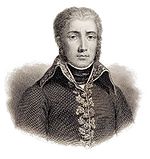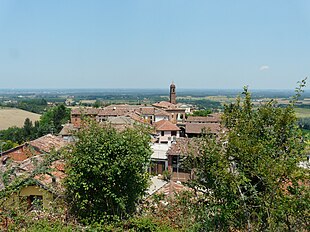
The Battle of Marengo was fought on 14 June 1800 between French forces under the First Consul Napoleon Bonaparte and Austrian forces near the city of Alessandria, in Piedmont, Italy. Near the end of the day, the French overcame General Michael von Melas' surprise attack, drove the Austrians out of Italy and consolidated Bonaparte's political position in Paris as First Consul of France in the wake of his coup d'état the previous November.
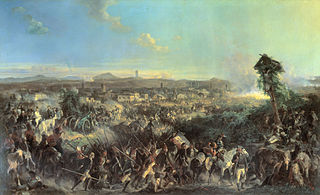
The Battle of Novi saw a combined army of the Habsburg monarchy and Imperial Russians under Field Marshal Alexander Suvorov attack a Republican French army under General Barthélemy Catherine Joubert. As soon as Joubert fell during the battle, Jean Victor Marie Moreau immediately took overall command of the French forces. After a prolonged and bloody struggle, the Austro-Russians broke through the French defenses and drove their enemies into a disorderly retreat, while French division commanders Catherine-Dominique de Pérignon and Emmanuel Grouchy were captured. Novi Ligure is in the province of Piedmont in Northern Italy a distance of 58 kilometres (36 mi) north of Genoa. The battle occurred during the War of the Second Coalition which was part of the French Revolutionary Wars.
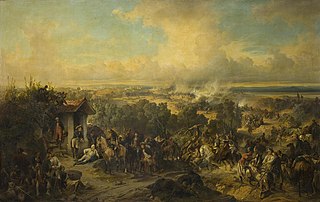
The Battle of (the) Trebbia was fought near the rivers of Tidone, Trebbia, and Nure in northern Italy between the joint Russian and Habsburg army under Alexander Suvorov and the Republican French army of Étienne-Jacques-Joseph-Alexandre Macdonald. Though French forces were moderately more numerous, the Austro-Russians severely defeated the French, sustaining about 5,500 casualties while inflicting losses of 16,500 on their enemies. The War of the Second Coalition engagement occurred west of Piacenza, a city located 70 kilometres (43 mi) southeast of Milan.

Count Alexander Vasilyevich Suvorov-Rymniksky, Prince of Italy, was a Russian general and military theorist in the service of the Russian Empire.

Jean-Mathieu-Philibert Sérurier, 1st Count Sérurier led a division in the War of the First Coalition and became a Marshal of the Empire under Emperor Napoleon. He was born into the minor nobility and in 1755 joined the Laon militia which was soon sent to fight in the Seven Years' War. After transferring into the regular army as an ensign, he was wounded at Warburg in 1760. He fought in the Spanish-Portuguese War in 1762. He married in 1779 after a promotion to captain. A newly minted major in 1789, the French Revolution sped up promotion so that he was colonel of the regiment in 1792. After leading Army of Italy troops in a number of actions, he became a general of brigade in 1793 and a general of division the following year.

The Italian campaigns of the French Revolutionary Wars (1792–1801) were a series of conflicts fought principally in Northern Italy between the French Revolutionary Army and a Coalition of Austria, Russia, Piedmont-Sardinia, and a number of other Italian states.

The Battle of Cassano was fought in 1799 from 27 to 28 April near Cassano d'Adda, which about 28 km (17 mi) ENE of Milan. The clash is part of the battle of the Adda River or the so-called forcing of the Adda, which on the first day of 26 April resulted in a minor victory for the Russians under the Count Suvorov over Barthélemy Schérer's French forces at Lecco. Then, on the second day, Suvorov's Austrians and Cossacks prevailed over Jean Moreau's army, who replaced Schérer as supreme commander, and trapped his isolated division on the third. The action took place during the War of the Second Coalition, as part of the larger conflict known as the French Revolutionary Wars.

The Siege of Genoa saw a Habsburg Austrian army led by General der Kavallerie Michael von Melas attack the port of Genoa defended by a Republican French army under General of Division (GD) André Massena during the War of the Second Coalition. The Austrian army isolated Massena and half of the French army in Genoa, while driving off the other half of the army. Once Genoa was laid under siege, Massena conducted a very active defense with frequent sorties. Besieged on the land side by 24,000 Austrians led by Feldmarschall-Leutnant (FML) Peter Karl Ott von Bátorkéz and on the seaside by a Royal Navy squadron, famine reduced the defenders to starvation. By the time Massena surrendered the city on 4 June, many thousands of Genoa's residents died of starvation. While the Austrian army was focused on the siege, Napoleon Bonaparte's army invaded Italy from the northwest, ultimately winning the Battle of Marengo.

The Italian and Swiss expedition of 1799 was a military campaign undertaken by a combined Austro-Russian army under overall command of the Russian Marshal Alexander Suvorov against French forces in Piedmont and Lombardy and the Helvetic Republic. The expedition was part of the Italian campaigns of the French Revolutionary Wars in general, and the War of the Second Coalition in particular. It was one of 'two unprecedented Russian interventions in 1799', the other being the Anglo-Russian invasion of Holland.
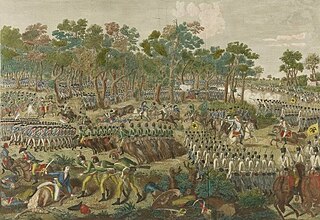
In the Battle of Magnano on 5 April 1799, an Austrian army commanded by Pál Kray defeated a French army led by Barthélemy Schérer. In subsequent battles, the Austrians and their Russian allies drove the French out of nearly all of Italy. This action was fought during the War of the Second Coalition, part of the French Revolutionary Wars.
The Battle of Genola or Battle of Fossano was a meeting engagement between a Habsburg Austrian army commanded by Michael von Melas and a Republican French army under Jean Étienne Championnet. Melas directed his troops with more skill and his army drove the French off the field, inflicting heavy losses. The War of the Second Coalition action represented the last major French effort in Italy during 1799. The municipality of Genola is located in the region of Piedmont in northwest Italy a distance of 27 kilometres (17 mi) north of Cuneo and 58 kilometres (36 mi) south of Turin.
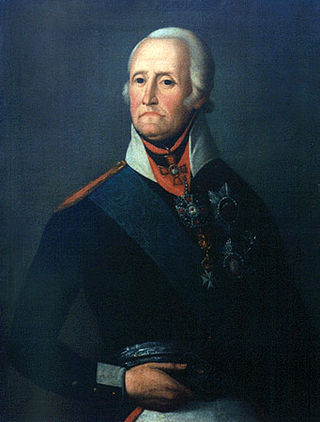
Diederich Arend von Rosenberg or Andrei Grigoryevich Rosenberg was an Imperial Russian general who led troops against Ottoman Turkey, the Polish–Lithuanian Commonwealth and Republican France. During the War of the Second Coalition he capably led an army corps under the famous Alexander Suvorov at Cassano, Bassignana and the Trebbia. In addition, his advance guard fought at Gavi when pursuing retreating French troops after the Battle of Novi. During Suvorov's Swiss campaign, Rosenberg's column took the Oberalp Pass around Lake Oberalpsee; while in independent command, he and his rearguard badly defeated a French force under André Masséna in the Battle of the Muotatal (Muottental/Muttental) on 30 September – 1 October 1799.
The Battle of Mannheim was fought between an Austrian army commanded by Archduke Charles, Duke of Teschen and a French army under Jacques Léonard Muller. Most of the French Army of the Rhine had retreated to the west bank of the Rhine River, leaving the division of Antoine Laroche Dubouscat to hold Mannheim on the east bank. Despite assistance by Michel Ney, Laroche's division was beaten and driven out of the city when attacked by Charles and a much superior force. The War of the Second Coalition action occurred in the city of Mannheim, today located in the state of Baden-Württemberg in southwest Germany about 80 kilometres (50 mi) south of Frankfurt.
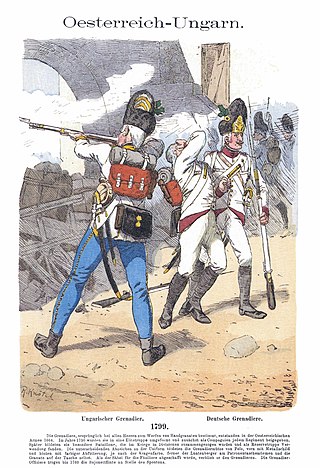
The First Battle of Marengo or Battle of San Giuliano saw Republican French soldiers under General of Division Jean Victor Marie Moreau launch a reconnaissance in force against a larger force of Habsburg Austrian and Imperial Russian troops led by Field Marshal Alexander Suvorov. The French enjoyed initial success, pressing back their opponents. However, large Austrian and Russian reinforcements soon arrived, causing the French to withdraw into Alessandria. This War of the Second Coalition meeting engagement occurred near the town of Spinetta Marengo, located just east of Alessandria in northwest Italy.

Andreas Karaczay de Vályeszáka or Andreas Karaiczay de Wallje Szaka or András Karacsaj de Válje-Szaka served in the Austrian army beginning in the Seven Years' War. In 1788–90, he fought in the Austro-Turkish War at Khotyn, Valea Seacă, Focșani, and Rymnik. In 1789 he was promoted to general officer, appointed Proprietor (Inhaber) of an Austrian cavalry regiment, and became a friend to the famous Russian General Alexander Suvorov. He fought in the French Revolutionary Wars until 1795 when he retired because of "war fatigue". Suvorov recalled him to action in 1799 when he fought at the Trebbia, Alessandria, and Novi. He led the Austrians at Second Novi. After being badly wounded at Stockach in 1800, he retired from his military offices in 1801.
The Second Battle of Marengo or Battle of Cascina Grossa saw French troops under General of Division Jean Victor Marie Moreau clash with a force of Austrian soldiers led by Feldmarschall-Leutnant Heinrich von Bellegarde. The early fighting between Emmanuel Grouchy's division and Bellegarde was inconclusive. However, late in the day Moreau committed Paul Grenier's French division to the struggle and the Austrians were driven from the field. This War of the Second Coalition battle occurred near Spinetta Marengo which is just east of Alessandria, Italy.

The Battle of Amsteg saw a Republican French division under General of Division Claude Lecourbe face a brigade of Habsburg Austrian soldiers led by General-major Joseph Anton von Simbschen. Lecourbe's offensive began on 14 August when six columns of French infantry advanced on the upper Reuss valley from the north and east. By 16 August, Lecourbe's forces had driven Simbschen's Austrians from the valley and seized control of the strategic Gotthard Pass between Italy and Switzerland.

The Battle of (the) Linth River saw a French division under General of Division Jean-de-Dieu Soult face a force of Austrian, Imperial Russian, and Swiss rebel soldiers led by Feldmarschall-Leutnant Friedrich Freiherr von Hotze in Switzerland. Soult carefully planned and his troops carried out a successful assault crossing of the Linth River between Lake Zurich and the Walensee. Hotze's death early in the action disorganized the Allied defenders who were defeated and forced to retreat, abandoning supplies accumulated for Field Marshal Alexander Suvorov's approaching army. On the same day, General of Division André Masséna's French Army of Helvetia defeated Lieutenant General Alexander Korsakov's Russian army in the Second Battle of Zurich and a French brigade turned back another Austrian force near Mollis. Both Korsakov's Russians and Hotze's survivors, led by Feldmarschall-Leutnant Franz Petrasch withdrew north of the Rhine River.

The battle of (the) Gotthard Pass, also known as the battle of the St. Gotthard Pass or the battle of the St. Gotthard, saw an Imperial Russian army commanded by Field Marshal Alexander Suvorov supported by two Austrian brigades attack a French division under General of Division Claude Lecourbe. The same day brought clashes at the Oberalp Pass and Hospental.
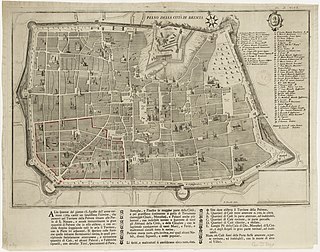
The capture of Brescia took place on 21 April 1799, during the Second Coalition war: General Field Marshal Count A. V. Suvorov's Russian and Habsburg troops took the fortress city of Brescia, having captivated the French garrison of General Bouzet.

